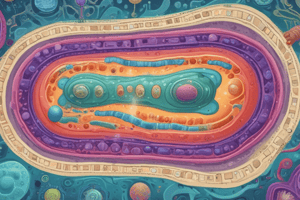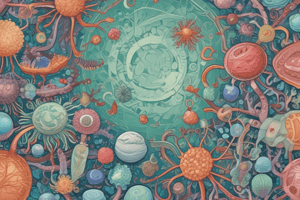Podcast
Questions and Answers
Some prokaryotes have ______, which allow them to stick to their substrate or other individuals in a colony
Some prokaryotes have ______, which allow them to stick to their substrate or other individuals in a colony
fimbriae
Pili (or sex ______) are longer than fimbriae and allow prokaryotes to exchange DNA
Pili (or sex ______) are longer than fimbriae and allow prokaryotes to exchange DNA
pili
Many bacteria exhibit ______, the ability to move toward or away from a stimulus
Many bacteria exhibit ______, the ability to move toward or away from a stimulus
taxis
Bacterial ______ are composed of a motor, hook, and filament
Bacterial ______ are composed of a motor, hook, and filament
Many prokaryotes form metabolically inactive ______, which can remain viable in harsh conditions for centuries
Many prokaryotes form metabolically inactive ______, which can remain viable in harsh conditions for centuries
Three factors contribute to their genetic diversity: rapid reproduction, mutation, and genetic ______
Three factors contribute to their genetic diversity: rapid reproduction, mutation, and genetic ______
Most of the genome consists of a circular ______ located in the nucleoid region
Most of the genome consists of a circular ______ located in the nucleoid region
Some species of bacteria also have smaller rings of DNA called ______
Some species of bacteria also have smaller rings of DNA called ______
Archaea share certain traits with bacteria and other traits with ______
Archaea share certain traits with bacteria and other traits with ______
Methanogens live in swamps and marshes and produce ______ as a waste product
Methanogens live in swamps and marshes and produce ______ as a waste product
Phototrophs obtain energy from ______.
Phototrophs obtain energy from ______.
In ______, some prokaryotes convert atmospheric nitrogen (N2) to ammonia (NH3).
In ______, some prokaryotes convert atmospheric nitrogen (N2) to ammonia (NH3).
Cyanobacteria are ______ that generate O2
Cyanobacteria are ______ that generate O2
Prokaryotes can be categorized by how they obtain energy and ______.
Prokaryotes can be categorized by how they obtain energy and ______.
Spirochetes are helical ______
Spirochetes are helical ______
A ______ cell attaches to a recipient by a pilus, pulls it closer, and transfers DNA.
A ______ cell attaches to a recipient by a pilus, pulls it closer, and transfers DNA.
Chlamydia trachomatis causes ______ and nongonococcal urethritis by sexual transmission
Chlamydia trachomatis causes ______ and nongonococcal urethritis by sexual transmission
In the cyanobacterium Anabaena, photosynthetic cells and nitrogen-fixing cells called ______ exchange metabolic products.
In the cyanobacterium Anabaena, photosynthetic cells and nitrogen-fixing cells called ______ exchange metabolic products.
Extreme halophiles live in highly ______ environments
Extreme halophiles live in highly ______ environments
Extreme thermophiles thrive in very ______ environments
Extreme thermophiles thrive in very ______ environments
Obligate ______ require O2 for cellular respiration.
Obligate ______ require O2 for cellular respiration.
Prokaryotes play a major role in the recycling of ______ elements between the living and nonliving components of ecosystems
Prokaryotes play a major role in the recycling of ______ elements between the living and nonliving components of ecosystems
A piece of DNA called the F ______ is required for the production of pili.
A piece of DNA called the F ______ is required for the production of pili.
[Blank] is the movement of genes between bacteria by bacteriophages (viruses that infect bacteria).
[Blank] is the movement of genes between bacteria by bacteriophages (viruses that infect bacteria).
Fungi are essential for the well-being of most ______ ecosystems.
Fungi are essential for the well-being of most ______ ecosystems.
Fungi use enzymes to break down a large variety of complex molecules into smaller ______ compounds.
Fungi use enzymes to break down a large variety of complex molecules into smaller ______ compounds.
Conidia are not formed inside ______; they are produced asexually at the tips of specialized hyphae called conidiophores
Conidia are not formed inside ______; they are produced asexually at the tips of specialized hyphae called conidiophores
Symbiotic relationships between fungi and animals are examples of ______ mutualism.
Symbiotic relationships between fungi and animals are examples of ______ mutualism.
Neurospora crassa, a ______ mold, is a model organism with a well-studied genome
Neurospora crassa, a ______ mold, is a model organism with a well-studied genome
Mycorrhizae are symbiotic relationships between fungi and ______.
Mycorrhizae are symbiotic relationships between fungi and ______.
The phylum Basidiomycota is defined by a clublike structure called a ______
The phylum Basidiomycota is defined by a clublike structure called a ______
Basidiomycetes are a group of fungi that include ______ and mushrooms.
Basidiomycetes are a group of fungi that include ______ and mushrooms.
Fungi are efficient decomposers of organic material including ______ and lignin
Fungi are efficient decomposers of organic material including ______ and lignin
Decomposition performed by fungi is important in an ecosystem because it helps ______ vital nutrients.
Decomposition performed by fungi is important in an ecosystem because it helps ______ vital nutrients.
Fungal cell walls contain ______.
Fungal cell walls contain ______.
The life cycle of a basidiomycete usually includes a long-lived ______ mycelium
The life cycle of a basidiomycete usually includes a long-lived ______ mycelium
A mycelium's structure maximizes its surface ______-to-volume ratio.
A mycelium's structure maximizes its surface ______-to-volume ratio.
Mushrooms are examples of ______ fruiting bodies
Mushrooms are examples of ______ fruiting bodies
Fungi perform essential recycling of chemical ______ between the living and nonliving world
Fungi perform essential recycling of chemical ______ between the living and nonliving world
Fungi are also used in ______ projects to clean up pollutants
Fungi are also used in ______ projects to clean up pollutants
Most fungi have hyphae divided into cells by ______, with pores allowing cell-to-cell movement of organelles
Most fungi have hyphae divided into cells by ______, with pores allowing cell-to-cell movement of organelles
Coenocytic fungi lack ______ and have a continuous cytoplasmic mass with hundreds or thousands of nuclei
Coenocytic fungi lack ______ and have a continuous cytoplasmic mass with hundreds or thousands of nuclei
Some fungi have ______ specialized to capture prey
Some fungi have ______ specialized to capture prey
Mycorrhizal fungi deliver ______ ions and minerals to plants
Mycorrhizal fungi deliver ______ ions and minerals to plants
The body is made of a mycelium, which is an interwoven mass of ______
The body is made of a mycelium, which is an interwoven mass of ______
A unique feature that helps identify the fungus is the presence of ______ cell walls
A unique feature that helps identify the fungus is the presence of ______ cell walls
Foresters inoculate pine seedlings with ______ to promote growth
Foresters inoculate pine seedlings with ______ to promote growth
Mycorrhizae are mutually beneficial relationships between fungi and ______ roots
Mycorrhizae are mutually beneficial relationships between fungi and ______ roots
Flashcards are hidden until you start studying
Study Notes
Prokaryotic Structures and Functions
- Some prokaryotes have fimbriae, which allow them to stick to their substrate or other individuals in a colony.
- Pili (or sex pili) are longer than fimbriae and enable prokaryotes to exchange DNA.
Locomotion
- Many bacteria exhibit taxis, the ability to move toward or away from a stimulus.
- Chemotaxis is the movement toward or away from a chemical stimulus.
- Most motile bacteria propel themselves by flagella scattered about the surface or concentrated at one or both ends.
- Bacterial flagella are composed of a motor, hook, and filament.
Internal Organization
- Prokaryotic cells usually lack complex compartmentalization.
- Some prokaryotes have in-foldings of the plasma membrane that perform metabolic functions.
- Most of the genome consists of a circular chromosome located in the nucleoid region.
- Some species of bacteria also have smaller rings of DNA called plasmids.
Prokaryotic Reproduction
- Prokaryotes reproduce by binary fission, which takes around 1-3 hours.
- They have short generation times, which contributes to their genetic diversity.
- Many prokaryotes form metabolically inactive endospores, which can remain viable in harsh conditions for centuries.
- Genetic diversity in prokaryotes is also contributed by rapid reproduction, mutation, and genetic recombination.
- Mutation rates during binary fission are low, but rapid reproduction allows mutations to accumulate rapidly in a population.
Genetic Recombination
- Transformation is the process where a prokaryotic cell takes up and incorporates foreign DNA from the surrounding environment.
- Transduction is the movement of genes between bacteria by bacteriophages (viruses that infect bacteria).
- Horizontal gene transfer is the movement of genes among individuals from different species.
Conjugation
- Conjugation is the process where genetic material is transferred between prokaryotic cells.
- During conjugation, a donor cell attaches to a recipient by a pilus, pulls it closer, and transfers DNA.
- A piece of DNA called the F factor is required for the production of pili.
Metabolism and Nutrition
- Prokaryotes can be categorized by how they obtain energy and carbon.
- Phototrophs obtain energy from light, while chemotrophs obtain energy from chemicals.
- Autotrophs require CO2 as a carbon source, and heterotrophs require an organic nutrient to make organic compounds.
- Energy and carbon sources are combined to give four major modes of nutrition.
Nitrogen Metabolism
- Nitrogen is essential for the production of amino acids and nucleic acids.
- In nitrogen fixation, some prokaryotes convert atmospheric nitrogen (N2) to ammonia (NH3).
- In the cyanobacterium Anabaena, photosynthetic cells and nitrogen-fixing cells called heterocysts exchange metabolic products.
Prokaryotic Metabolism
- Prokaryotic metabolism varies with respect to O2.
- Obligate aerobes require O2 for cellular respiration, while obligate anaerobes are poisoned by O2 and use fermentation or anaerobic respiration.
- Facultative anaerobes can survive with or without O2.
Prokaryotic Diversity
- Domain Archaea shares certain traits with bacteria and other traits with eukaryotes.
- Some archaea live in extreme environments and are called extremophiles.
- Extreme halophiles live in highly saline environments, while extreme thermophiles thrive in very hot environments.
- Methanogens live in swamps and marshes and produce methane as a waste product.
Domain Bacteria
- Proteobacteria include photoautotrophs, chemoautotrophs, and heterotrophs.
- Some proteobacteria are anaerobic, while others are aerobic.
- Chlamydia are parasites that live only within animal cells.
- Spirochetes are helical heterotrophs, which can be parasitic.
- Cyanobacteria are photoautotrophs that generate O2.
Gram-Positive Bacteria
- Actinomycetes decompose organic matter.
- Bacillus anthracis causes anthrax, while Clostridium botulinum causes botulism.
- Some Staphylococcus and Streptococcus can be pathogenic.
- Mycoplasms are the smallest known cells.
Ecological Importance
- Prokaryotes play a major role in the recycling of chemical elements between the living and nonliving components of ecosystems.
- Chemoheterotrophic prokaryotes function as decomposers, breaking down dead organisms and waste products.
- Prokaryotes can increase the availability of nitrogen, phosphorus, and potassium for plant growth.
Symbiosis
- Symbiosis is an ecological relationship in which two species live in close contact: a larger host and smaller symbiont.
Fungal Characteristics
- Fungi are diverse and widespread, with approximately 100,000 described species and an estimated 1.5 million total species
- They are essential for terrestrial ecosystems, breaking down organic material and recycling vital nutrients
- Fungi are heterotrophs, absorbing nutrients from outside their bodies using enzymes to break down complex molecules
- They exhibit diverse lifestyles, including decomposers, parasites, and mutualists
Morphology
- Fungi grow as either filaments (hyphae) or yeasts, with some species capable of growing as both
- Multicellular fungi have a morphology that enhances their ability to absorb nutrients
- Fungi consist of mycelia, networks of branched hyphae adapted for absorption
- A mycelium's structure maximizes its surface area-to-volume ratio
- Fungal cell walls contain chitin
- Most fungi have hyphae divided into cells by septa, with pores allowing cell-to-cell movement of organelles
- Coenocytic fungi lack septa and have a continuous cytoplasmic mass with hundreds or thousands of nuclei
Specialized Hyphae
- Some fungi have hyphae specialized to capture prey
- Some unique fungi have specialized hyphae called haustoria, allowing them to penetrate the tissues of their host
- Most vascular plants have mycorrhizae, mutually beneficial relationships between fungi and plant roots
- Mycorrhizal fungi deliver phosphate ions and minerals to plants
- Types of mycorrhizal fungi include ectomycorrhizal fungi (do not penetrate root cells) and arbuscular mycorrhizal fungi (penetrate root cells)
Phylum Basidiomycota
- Includes mushrooms, puffballs, and shelf fungi, mycorrhizae, and plant parasites
- Defined by a clublike structure called a basidium, a transient diploid stage in the life cycle
- Also called club fungi
- Many basidiomycetes are decomposers of wood
- Life cycle usually includes a long-lived dikaryotic mycelium that reproduces sexually by producing elaborate fruiting bodies called basidiocarps
- Mushrooms are examples of basidiocarps
- Basidia in a basidiocarp are sources of sexual spores called basidiospores
Conidia
- Not formed inside sporangia, but produced asexually at the tips of specialized hyphae called conidiophores
Ecological Roles of Fungi
- Decomposition: fungi are efficient decomposers of organic material, including cellulose and lignin
- Recycling: fungi perform essential recycling of chemical elements between the living and nonliving world
- Bioremediation: fungi are used in bioremediation projects
Studying That Suits You
Use AI to generate personalized quizzes and flashcards to suit your learning preferences.




